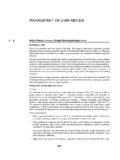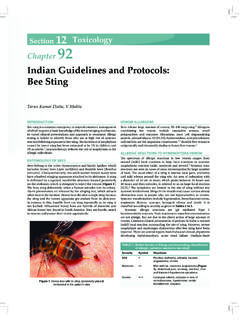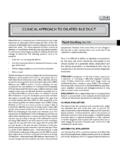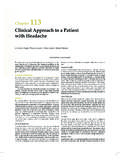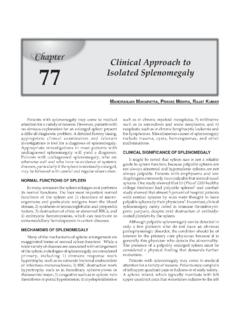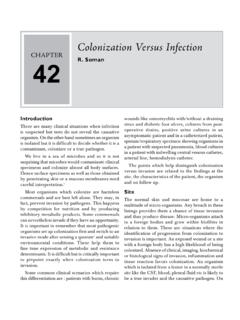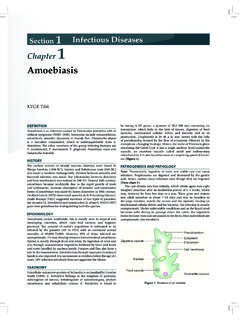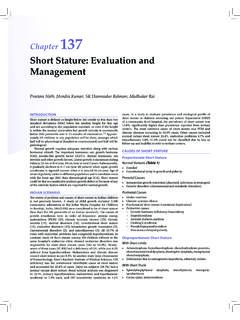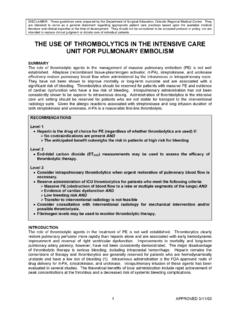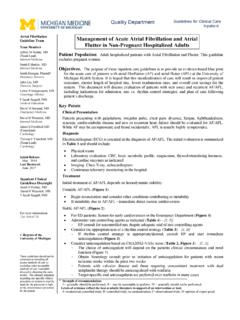Transcription of Acute Respiratory failure - Algorithmic Approach ...
1 Acute Respiratory failure - Algorithmic Approach - diagnosis and management GC Khilnani*, C Bammigatti**. 111. Additional Professor , **Senior Resident, *. Departments of Medicine, All India Institute of Medical Sciences, New Delhi-110029. A b s t r ac t Acute Respiratory failure is a common clinical condition encountered in emergency department and intensive care units (ICU). This clinical entity has varied etiology and high morbidity and morality despite aggressive monitoring and treatment. The aim of this chapter is to understand the classification, etiology, clinical features, diagnosis and management of Acute Respiratory failure . Type 1 (hypoxaemic) Respiratory failure is most often associated with those conditions that affect the interstitium and alveolar walls of the lungs. It is often associated with marked VA/Q. mismatching and oxygen is the critical therapy in the management of these patients. Alveolar hypoventilation leads to type 2 (hypercapnic) Respiratory failure , the most common cause of which is Acute exacerbation of COPD.
2 Various clinical features helps in assessment of patients with Acute Respiratory failure , however, arterial blood gas analysis is the mainstay of diagnosis . The management of patients with Acute Respiratory failure varies according to the etiology with the primary aim to maintain a patent airway and ensure adequate alveolar ventilation. Lung protective ventilation is found to improve outcome of ARDS patients markedly. In carefully selected patients, non-invasive positive pressure ventilation (NIPPV) is found to decrease the rate of intubation, mortality and nosocomial pneumonia. Quite often patients with Acute Respiratory failure need mechanical ventilation, which require intricate management depending upon the cause of Respiratory failure . With the currently available advanced ventilators for mechanical ventilation, a large proportion of patients can be liberated from mechanical ventilation. Respiratory failure is a syndrome in which the Respiratory system circulation.
3 At the same time patient should be evaluated for fails to maintain an adequate gas exchange at rest or during exercise the cause of Respiratory failure and therapeutic plan should be resulting in hypoxemia with or without concomitant hypercarbia. derived from an informed clinical and laboratory examination Despite many technical advances in diagnosis , monitoring and supplemented by the results of special intensive care unit therapeutic intervention, Acute Respiratory failure continues to be (ICU) interventions. Recent advances in the ICU management a major cause of morbidity and mortality in intensive care unit and monitoring technology facilitates early detection of the (ICU) setting. This chapter describes the classification, etiology, pathophysiology of vital functions, with the potential for clinical features, diagnosis and management of this common prevention and early titration of therapy for the patients with condition of varied etiology. Acute Respiratory failure which improves the outcome.
4 Respiratory failure (RF) is diagnosed when the patient loses the ability to ventilate adequately or to provide sufficient oxygen to Respiratory failure is classified as type 1 Respiratory failure or the blood and systemic organs. Clinically Respiratory failure is type 2 Respiratory failure ( ).2 Type 1 Respiratory failure is diagnosed when PaO2 is less than 60mm of Hg with or without defined by a PaO2 of <60mmHg with a normal or low PaCO2. elevated CO2 level, while breathing room air. High mortality Type 2 Respiratory failure is defined by a PaO2 of <60mHg and a rates are common for patients with Acute Respiratory failure , even PaCO2 of > Respiratory failure is also classified as Acute , in ICUs specializing in modern critical care techniques. In an Acute on chronic or This distinction is important in International multicenter study, only patients with Acute deciding on whether the patient needs to be treated in intensive Respiratory failure survived their hospitalization whereas care unit (ICU) or can be managed in general medical ward died in the Urgent resuscitation of the patient requires and most appropriate treatment strategy, particularly in type 2.
5 Airway control, ventilator management , and stabilization of the Respiratory failure . 547. Acute Respiratory failure - Algorithmic Approach - diagnosis and management Respiratory failure Table 2 : Common causes of type 2 Respiratory failure Chronic bronchitis and emphysema Asthma Drug overdose Type 1 (hypoxemic) Type 2 (Hypercarbic) Poisoning Low PaO2, normal or low PaCO2 Low PaO2, high PaCO2 Myasthenia gravis Polyneuropathy Poliomyelitis Primary muscle disorders Porphyria Acute Chronic Acute Chronic Cervical cord disorders * Hypoxemia and hypercarbic Respiratory failure frequently coexist. Primary alveolar hypoventilation Either may be Acute or chronic. Sleep apnea syndrome Pulmonary oedema : Classification of Respiratory failure Acute Respiratory distress syndrome Laryngeal oedema Foreign body Table 1 : Common causes of type 1 (hypoxaemic). Respiratory failure units with high VA /Q ratios) or venous admixture (increased Chronic bronchitis and emphysema lung units with low VA /Q ratios).
6 VA /Q mismatching accounts Pneumonia for the hypoxemia in the great majority of cases. As control of Pulmonary edema ventilation in these patient is usually intact, ventilation increase Pulmonary fibrosis in response to a raised PaCO2, so that the excess CO2 is excreted Asthma by the normal areas of the lungs. This hyperventilation cannot Pneumothorax result in further improvement in the normal areas of the lungs, Pulmonary embolism since the blood there is already fully oxygenated. Thromboembolic pulmonary hypertension Alveolar hypoventilation leads to type 2 Respiratory failure . When Lymphatic carcinomatosis the PaCO2 rises due to alveolar hypoventilation, the PaO2 must Pneumoconiosis fall; knowing one of these values, the other may be predicted Granulomatous lung disease using the alveolar air equation. The most common cause of type Cyanotic congenital heart disease 2 Respiratory failure is COPD. Other causes leading to type 2. Acute Respiratory distress syndrome Respiratory failure are listed in Table 2.
7 Fat embolism Pulmonary arteriovenous fistulae If Respiratory failure is of sudden onset, the Acute rise in PaCO2. results in a rise in hydrogen ion concentration leading to fall in Acute hypercarbic Respiratory failure is characterized pH. If Respiratory failure develops slowly, renal compensation by a patient with no, or minor, evidence of pre-existing with retention of bicarbonate results in near-normal Respiratory disease and arterial blood gas tensions will show Clinical features high PaCO2, low pH, and normal bicarbonate. Acute on chronic hypercarbic Respiratory failure is Clinical features of hypoxemia characterized by an Acute deterioration in an individual with Hypoxemia results in central cyanosis that is best assessed by significant pre-existing hypercarbic Respiratory failure , high examining the oral mucous membranes, since blood flow at these PaCO2, low pH, and high bicarbonate. sites is well maintained when the periphery may be vasoconstricted.
8 Chronic hypercarbic Respiratory failure is characterized by The relationship between cyanosis and hypoxemia, however, is the evidence of chronic Respiratory disease, high PaCO2, variable and there is wide inter-observer ,6 Cyanosis is more easily observed in polycythaemic patients, whereas in normal pH and high bicarbonate. anemic patients there may be insufficient reduced hemoglobin to The causes of Respiratory failure are diverse. In general most produce a blue color to the mucus membranes. pulmonary and cardiac causes of Respiratory failure lead to hypoxemia without hypercarbia (Type 1 Respiratory failure ). This Hypoxemia affects the central nervous system (CNS), causing irritability, impaired intellectual function and clouding of type of Respiratory insufficiency is most often associated with consciousness, which may progress to convulsions, coma and those conditions that affect the interstitium and alveolar walls of death. A level of Acute hypoxemia that might be dangerous to a the lungs, fibrosing alveolitis and pulmonary edema, but is previously healthy individual may be well tolerated by patients also seen in other conditions such as pulmonary embolism and with chronic hypoxia.
9 Hypoxemia stimulates ventilation via pneumonia. It may also be seen in obstructive lung disease, such the carotid chemoreceptor, increases heart rate and cardiac as COPD and asthma (Table 1). output and dilates peripheral vessels. Cardiac dysrhythmias may In all these conditions VA /Q mismatching is marked, resulting in occur, which may be exaggerated by concomitant digitalis or either increased dead space or wasted ventilation (increased lung The pulmonary arteries respond to hypoxia by 548. Medicine Update 2005. vasoconstricting, producing increased vascular resistance and Type 1 Respiratory failure pulmonary hypertension, with the later development of right This condition usually presents little difficulty and apart ventricular enlargement or cor pulmonale. Persistent hypoxia from the use of oxygen, treatment of the primary cause results in secondary polycythaemia due to increased production ( antibiotics for lobar pneumonia), may be all that it of erythropoietin.)
10 Required. Arterial hypoxemia when extremely severe can be life Clinical features of hypercarbia threatening and therefore should have the highest priority The effects of hypercarbia are variable from patient to patient. when managing Acute Respiratory failure . The goal should There is a poor correlation between PaCO2 and the development be to increase hemoglobin O2 saturation to at least 85- of these effects, as changes in PaCO2 may be more important than 90% without risking significant oxygen toxicity. Very high the actual level. The central nervous system (CNS) manifestation FiO2 levels can be safely used for brief periods of time. The of hypercarbia is irritability, confusion, somnolence and ,9 use of positive end-expiratory pressure (PEEP), changes in Coma is uncommon in patients with COPD and Respiratory position, sedation and paralysis may be helpful in lowering failure when breathing room air because the level of PaCO2 FiO2. Fever, agitation, overfeeding, vigorous Respiratory necessary to cause coma is usually associated with a PaO2 activity and sepsis can all markedly increase VO2.

